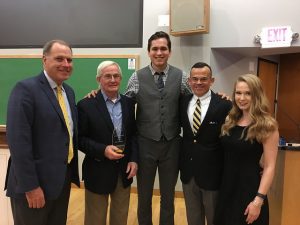Former Pittsburgh mayor gives talk in Quigley Auditorium
Murphy emphasizes investments, discusses cooperation with past projects
Former Mayor of Pittsburgh Tom Murphy joined students in the Quigley Auditorium to discuss urban revitalization and how Pittsburgh became a remade city on Friday, Sept. 22, during a session of the Center for Business and Economics’ Lunchtime Learning Lecture Series.
The presentation focused on how local government makes partnerships based on the interest of cities. Converging forces of globalization, environmental concerns, technological innovation, demographics, financing the future and talent affect the lives of every person and every city on the earth, according to Murphy. A successful 21st century city must be well managed, vibrant, entrepreneurial, educated, able to attract talent and have partnerships.
“The reality is that the cities that are succeeding are the cities that are making investments in the future,” Murphy said.
Troy Elphinstone, ’19, who is a Center for Business and Economics fellow introduced Tom Murphy. Elphinstone gave the audience of both students and the general public an outline of Murphy’s experience.
“As a three-term mayor of Pittsburgh between 1994 and 2006, he initiated a public, private partnership strategy that leveraged Carnegie Mellon University’s academic presence to create regional economic development,” Elphinstone said.
Murphy emphasized the need to make investments not to maintain, but to invest in the future.
“You will succeed in life if you are intentional,” Murphy said.
The presentation went on to discuss success stories of cities like Seattle and Cincinnati. Murphy spoke about the importance of public and private partnerships to develop communities. Minneapolis developed a remarkable partnership between the business community, political leadership, universities and hospitals.
Murphy went on to discuss his three terms as mayor of Pittsburgh between 1994 and 2006. When Murphy entered office, Pittsburgh had a diminishing population due to young people moving away.
“We had to reimagine Pittsburgh,” Murphy said.
Murphy talked about how the population loss created the reimagining of Pittsburgh.
“Between 1970 and 1990 we lost almost 400,000 people from the Pittsburgh region,” Murphy said.
Pittsburgh seemed to have been in a downward trajectory. With the use of intentional city planning, Murphy and the city of Pittsburgh were able to turn the population loss around.
“Pittsburgh and Allegheny County is now leading in the number of young people moving to Pittsburgh … because we have become a different kind of place,” said Murphy.
Chris Allison, ’83, is a native of Pittsburgh. Allison believes without Mayor Murphy, Pittsburgh would not have developed into a prominent city.
“One of the most vibrant communities in America. Once a city of smokestacks and steel. It’s now a city of technological and life sciences innovation, culture and a richly diverse population, but it wasn’t always that way,” Allison said.
Allison was not the only person to notice Pittsburgh’s rise from a city of industry to a city of innovation and culture.
“We moved from being one of the most economically depressed areas in America and most environmentally degraded in the 1950s to now being ranked as one of the most liveable cities in America,” Murphy said.
Murphy continued to discuss development projects in Pittsburgh.
“We needed to do something with the thousands of acres of abandoned steel mills and businesses around Pittsburgh. We made a decision, even though we were flat broke to figure out how to buy the property,” Murphy said.
Where the Cheesecake Factory in SouthSide Works was created is where 10,000 men and women once made steel, according to Murphy.
The South Side Works project was a success, according to Murphy.
“One hundred-twenty-eight million dollars in public money from a flat broke city, generated close to $800 million in investment,” Murphy said.
Projects like SouthSide Works were not easy, according to Murphy.
“It wasn’t easy to start companies in Pittsburgh. Not a lot of investors were willing to invest in it … we created a partnership to help small businesses get started,” Murphy said.
Juliana Sebolt, ’20, who currently lives in the greater Pittsburgh Area, attended the event.
“It was interesting to live in modern Pittsburgh and to hear about how Pittsburgh was different only a few years ago. All of the work that went into developing Pittsburgh was shocking,” Sebolt said.
Murphy talked about changes made in downtown Pittsburgh.
“Downtown Pittsburgh was our red light district, that we call the Cultural Trust now. There were 22 massage parlors and strip joints, in a three block by seven block area. The Heinz endowment, Mr. Heinz saw in that one [run]down, seedy place an opportunity to make what we call the Cultural Trust,” Murphy said.
Murphy used the Benedum Theater as an example of when the private and philanthropic sectors are able to work together in the interest of development.
Murphy had a hand in building a new football stadium, as well as a new baseball park and convention center that was the largest certified green building in America. Murphy believes in the power of investment and moving toward the future.
“Where are you, are you here or are you reaching for the future?” Murphy said.

Allegheny President Jim Mullen, former Pittsburgh Mayor Tom Murphy, Center for Business and Economics Fellow Troy Elphinstone, ‘19, Chris Allison, ‘83, and CBE Fellow Samantha Bretz, ’18, stand together after Murphy’s talk in Quigley Auditorium on Friday, Sept. 22, 2017.








